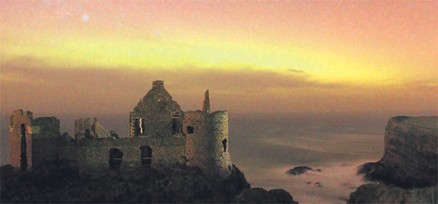Bathed in an eerie light, this strange image of Dunluce Castle hasn't been digitally enhanced - whatever you may think. The windswept fortification perched on the cliffs of the north Antrim coast isn't catching the dawn light nor the last of the evening sunshine.
The reason for its peculiar appearance is that the landmark site is drenched in the rarely sighted illumination of the aurora borealis - or the northern lights.
Indeed, this particular snap is the handiwork of Maghera photographer Conor McDonald, who waited patiently for hours to capture perfection.
"I was following the path of the aurora so I headed up to Dunluce Castle and waited for it to get dark," said the 21-year-old.
There have been sightings of the startling natural phenomenon in recent weeks as the Earth sweeps through clouds of electrically charged particles blasted out from the sun, just as we emerge from the slowest point of an 11-year Sun cycle.
Meanwhile, 25-year-old Reed Ingram Weir, a professional photographer from Ballycastle, also took some impressive pictures.
"I go around the world trying to shoot the northern lights, but these are the best shots I've ever taken in the UK because they don't normally come this far south," he said.
Terry Mosel of the Irish Astronomical Association said the particles are constantly fired out from the Sun in different directions but it's rare that one of those clouds crosses the Earth's path.
But if it does come to Earth, the particles can become trapped in the planet's magnetic field and dragged downwards towards the north and south magnetic poles, spiralling into the atmosphere.
There they may interact with atoms high in the Earth's atmosphere to create the aurora borealis in the northern hemisphere and the aurora australis in the south.
"What we see is the effect of the atoms in the upper atmosphere being excited by the particles and they are made to glow. The colours you get are the result of the particles interacting with different kinds of atom," Terry said.
"Reds and greens are nitrogen and oxygen and if you get both together you sometimes get purple. You can get them at slightly different heights, giving several colours.
"The further north you go the closer you are to the north magnetic pole, so the more you see of them. If you're in Iceland or northern Scandinavia or Alaska, you will see them more.
"But if there is a really powerful outbreak, the effect spreads further and further south away from the pole and there's a chance to see them in Northern Ireland. They've even been seen south of Cork, but that would be rare - you're more likely to see them in Donegal, north Derry and north Antrim.
"The sun has been relatively quiet for a couple of years. Sun activity goes through an 11-year cycle," Terry added.
"We've just emerged from a long deep minimum of activity in 2009 and 2010 and now it's starting to pick up again, so there should be more and more sightings in the next couple of years. The next one could be next week or it could be a couple of months away."
The scientific name for the particle clouds is 'coronal mass ejections', with the particles blasted out into space and travelling at several hundred thousand miles per hour. It's pure luck if it comes in the direction of Earth.
"You need to be away from the pollution of city lights if possible, you need a clear sky and you're less likely to see it in bright moonlight - so those conditions don't crop up all that often," Terry said.
Background
An aurora is a natural light display in the sky, particularly in the polar regions, caused by the collision of charged particles directed by Earth's magnetic field. An aurora is usually observed at night and typically occurs in the ionosphere. In northern latitudes, the effect is known as the aurora borealis (or the northern lights), named after the Roman goddess of dawn, Aurora, and the Greek name for the north wind, Boreas, by Pierre Gassendi in 1621. Auroras near the magnetic pole may be high overhead, but from farther away, they illuminate the northern horizon as a greenish glow or sometimes a faint red, as if the Sun were rising from an unusual direction.
More Pictures




Reader Comments
to our Newsletter